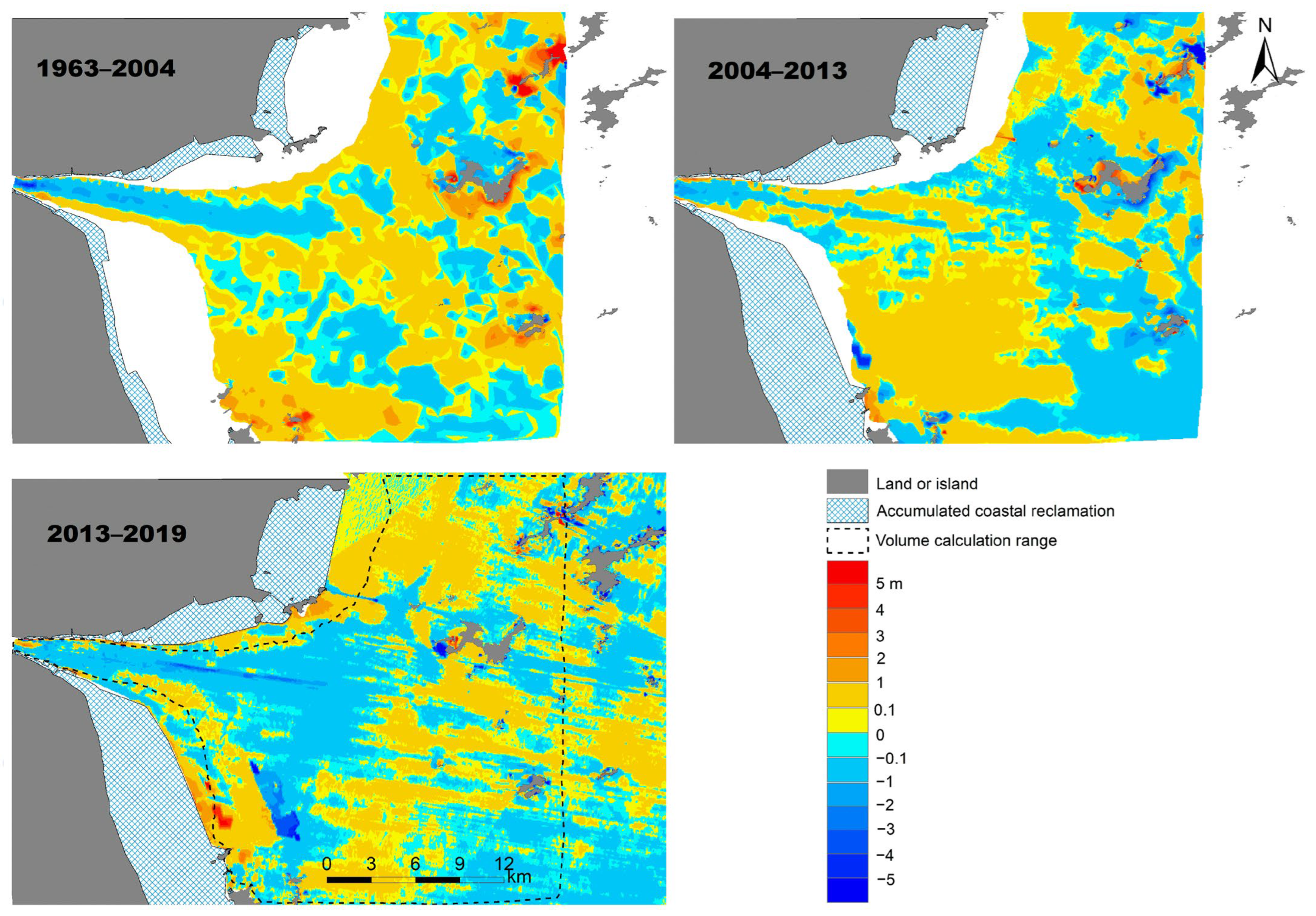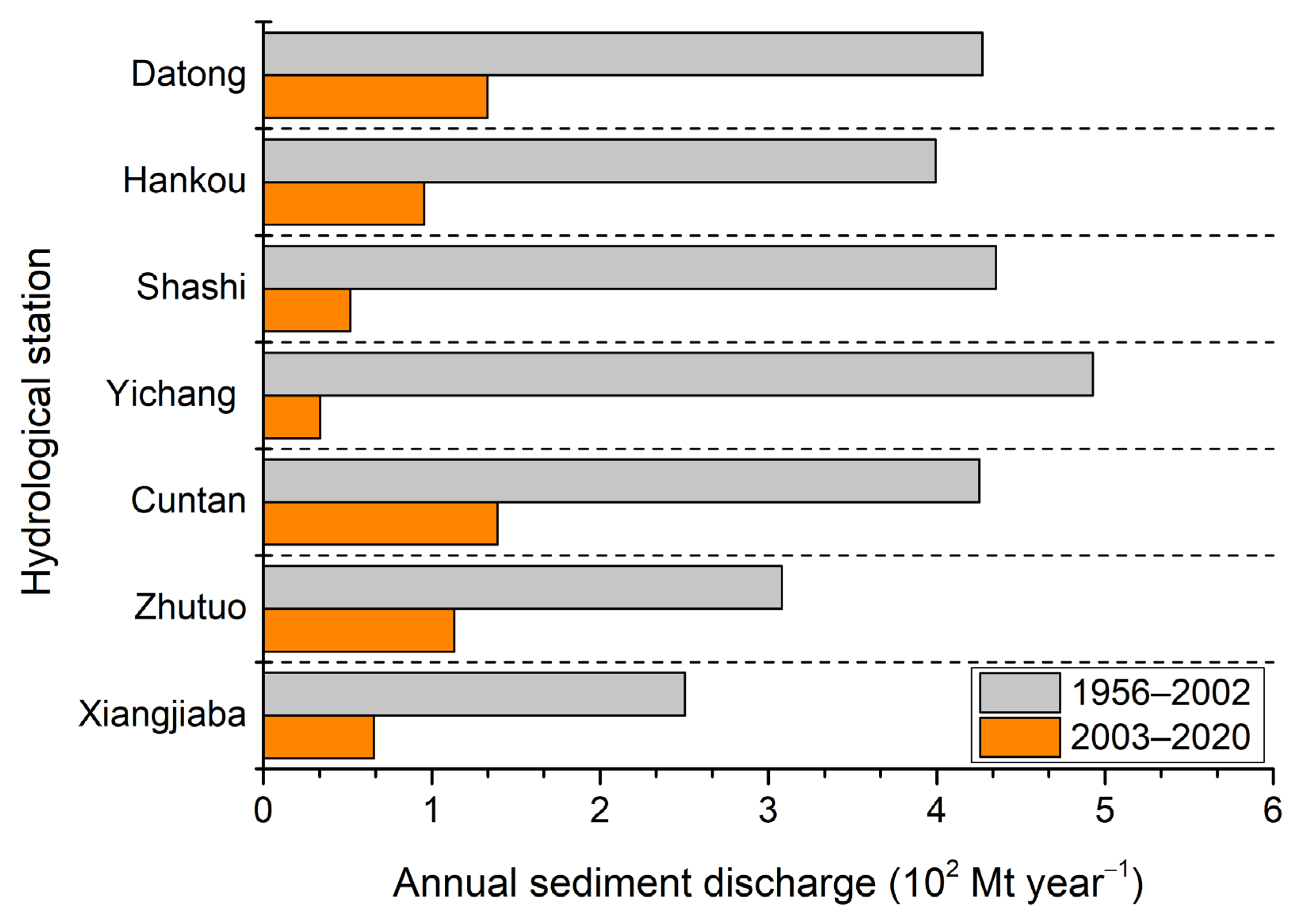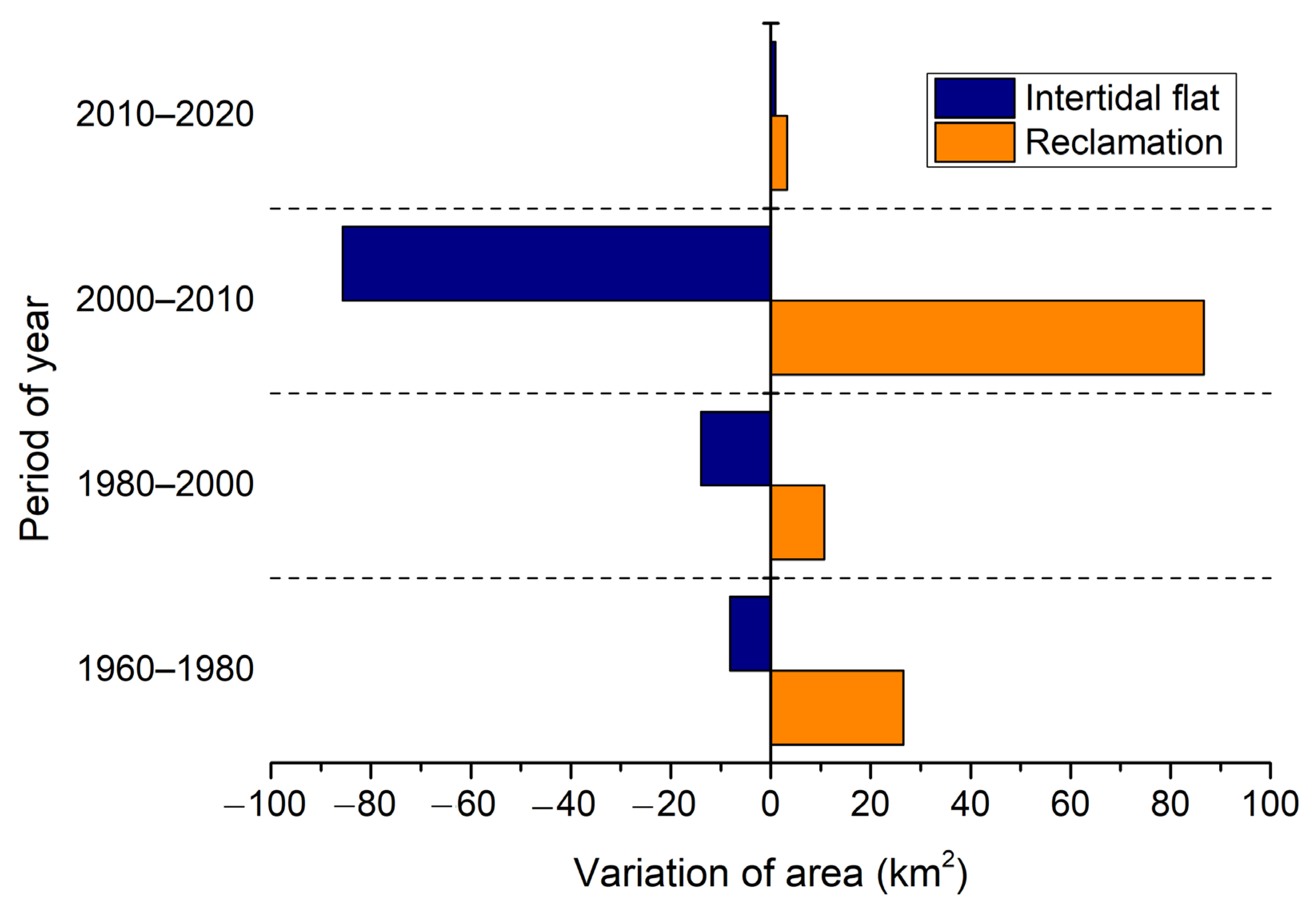Effects of Coastal Reclamation on the Topographic Changes of an Open Estuary: A Case Study in Taizhou Bay, East China
Abstract
:1. Introduction
2. Study Area
3. Materials and Methods
3.1. Bathymetric Data
3.2. Remote Sensing Data
3.3. Historical Documents
4. Results
4.1. Process of Coastal Reclamations
4.2. Topographic Changes in Taizhou Bay
5. Discussion
5.1. Effects of Coastal Reclamation on Topographic Changes
5.2. Influence of the Decreasing Supply of Sediment
5.3. Feedback Mechanism between Morphological Evolution and Coastal Reclamation
6. Conclusions
Author Contributions
Funding
Data Availability Statement
Acknowledgments
Conflicts of Interest
References
- Allen, J.R.L. Morphodynamics of Holocene salt marshes: A review sketch from the Atlantic and Southern North Sea coasts of Europe. Quat. Sci. Rev. 2000, 19, 1155–1231. [Google Scholar] [CrossRef]
- Studds, C.E.; Kendall, B.E.; Murray, N.J.; Wilson, H.B.; Rogers, D.I.; Clemens, R.S.; Gosbell, K.; Hassell, C.J.; Jessop, R.; Melville, D.S.; et al. Rapid population decline in migratory shorebirds relying on Yellow Sea tidal mudflats as stopover sites. Nat. Commun. 2017, 8, 14895. [Google Scholar] [CrossRef] [PubMed]
- Barbier, E.B.; Hacker, S.D.; Kennedy, C.; Koch, E.W.; Stier, A.C.; Silliman, B.R. The value of estuarine and coastal ecosystem services. Ecol. Monogr. 2011, 81, 169–193. [Google Scholar] [CrossRef]
- Wang, J.; Dai, Z.; Mei, X.; Fagherazzi, S. Tropical cyclones significantly alleviate mega-deltaic erosion induced by high riverine flow. Geophys. Res. Lett. 2020, 47, e2020GL089065. [Google Scholar] [CrossRef]
- Kremer, H.H.; Le Tissier, M.D.A.; Burbridge, P.R.; Talaue-Mcmanus, L.; Rabalais, N.N.; Parslow, J.; Crossland, C.J.; Young, B. Land-Ocean Interactions in the Coastal Zone: Science Plan and Implementation Strategy; IGBP Report 51/IHDP Report 18; IGBP Secretariat: Stockholm, Sweden, 2005; pp. 1–68. [Google Scholar]
- Van Maren, D.S.; Oost, A.P.; Wang, Z.B.; Vos, P.C. The effect of land reclamations and sediment extraction on the suspended sediment concentration in the Ems Estuary. Mar. Geol. 2016, 376, 147–157. [Google Scholar] [CrossRef]
- Murray, N.J.; Worthington, T.A.; Bunting, P.; Duce, S.; Hagger, V.; Lovelock, C.E.; Lucas, R.; Saunders, M.I.; Sheaves, M.; Spalding, M.; et al. High-resolution mapping of losses and gains of Earth’s tidal wetlands. Science 2022, 376, 744–749. [Google Scholar] [CrossRef]
- Murray, N.J.; Phinn, S.R.; DeWitt, M.; Ferrari, R.; Johnston, R.; Lyons, M.B.; Clinton, N.; Thau, D.; Fuller, R.A. The global distribution and trajectory of tidal flats. Nature 2019, 565, 222–225. [Google Scholar] [CrossRef]
- Friedrichs, C.T.; Aubrey, D.G. Non-linear tidal distortion in shallow well-mixed estuaries: A synthesis. Coast. Shelf Sci. 1988, 27, 521–545. [Google Scholar] [CrossRef]
- Speer, P.E.; Aubrey, D.G. A study of non-linear tidal propagation in shallow inlet/estuarine systems Part II: Theory. Estuar. Coast. Shelf Sci. 1985, 21, 207–224. [Google Scholar] [CrossRef]
- Jia, J.J.; Gao, S.; Xue, Y.C. Sediment dynamic processes of the Yuehu inlet system, Shandong Peninsula, China. Estuar. Coast. Shelf Sci. 2003, 57, 783–801. [Google Scholar] [CrossRef]
- ECCHE (Editorial Committee for Chinese Harbours and Embayments). Chinese Harbours and Embayments (Part VI); China Ocean Press: Beijing, China, 1993; pp. 43–46. (In Chinese) [Google Scholar]
- Guo, C. Response of Jiaojiang Estuary to Coastal Reclamation; Zhejiang University: Hangzhou, China, 2016; pp. 67–90, (In Chinese with English Abstract). [Google Scholar]
- Li, B.G.; Wang, C.H.; Zhou, H.Q.; Wu, X.Y.; Yang, H. Adjustment mechanism on the erosion and accretion of riverbed in the Jiaojiang Estuary in Zhejiang Province, China. Acta Oceanol. Sin. 2009, 31, 89–100, (In Chinese with English Abstract). [Google Scholar]
- Xie, Q.C.; Zhang, L.R.; Li, B.G. Analysis of accumulation in the Taizhou Bay. Donghai Mar. Sci. 1988, 6, 25–33, (In Chinese with English Abstract). [Google Scholar]
- Mai, M.; Yan, Y.; Wu, Y.X. Analysis on hydrographical environment and seabed morphological processes characteristics in Taizhou Bay. J. Waterw. Habor 2009, 30, 246–252, (In Chinese with English Abstract). [Google Scholar]
- Milliman, J.D.; Shen, H.T.; Yang, Z.S.; Meade, R.H. Transport and deposition of river sediment in the Changjiang estuary and adjacent continental shelf. Contin. Shelf Res. 1985, 4, 37–45. [Google Scholar] [CrossRef]
- Xie, D.F.; Pan, C.H.; Wu, X.G.; Gao, S.; Wang, Z.B. Local human activities overwhelm decreased sediment supply from the Changjiang River: Continued rapid accumulation in the Hangzhou Bay-Qiantang Estuary system. Mar. Geol. 2017, 392, 66–77. [Google Scholar] [CrossRef]
- Li, Y.; Wolanski, E.; Xie, Q.C. Coagulation and settling of suspended sediment in the Jiaojiang River Estuary, China. J. Coast. Res. 1993, 9, 390–402. [Google Scholar]
- Bi, A.H.; Sun, Z.L. A preliminary study on the estuarine processes in the Jiaojiang River, China. J. Sediment. Res. 1984, 3, 12–26, (In Chinese with English Abstract). [Google Scholar]
- Dong, L.X.; Wolanski, E.; Li, Y. Field and modeling studies of fine sediment dynamics in the extremely turbid Jiaojiang River estuary, China. J. Coast. Res. 1997, 13, 995–1003. [Google Scholar]
- Zhu, Y.K. Some characteristics of stream-like macro-tidal estuary (Jiaojiang). Geogr. Study 1986, 5, 21–29, (In Chinese with English Abstract). [Google Scholar]
- Guan, W.B.; Kot, S.C.; Wolanski, E. 3-D fluid-mud dynamics in the Jiaojiang Estuary, China. Estuar. Coast. Shelf Sci. 2005, 65, 747–762. [Google Scholar] [CrossRef]
- Guan, W.B.; Wolanski, E.; Dong, L.X. Cohesive sediment transport in the Jiaojiang River estuary, China. Estuar. Coast. Shelf Sci. 1998, 46, 861–871. [Google Scholar] [CrossRef]
- Fu, N.P.; Bi, A.H. Discussion on the problems in the sediment transport of the Jiaojiang River. J. Sediment. Res. 1989, 8, 51–57, (In Chinese with English Abstract). [Google Scholar]
- Hu, Q.H.; Zhang, X.M. New pattern of river evolution and systematic protection and governance in China. China Water Resour. 2024, 7, 1–8, (In Chinese with English Abstract). [Google Scholar]
- Dai, Z.J.; Fagherazzi, S.; Mei, X.F.; Chen, J.Y.; Meng, Y. Linking the infilling of the North Branch in the Changjiang (Yangtze) estuary to anthropogenic activities from 1958 to 2013. Mar. Geol. 2016, 379, 1–12. [Google Scholar] [CrossRef]
- Wei, W.; Dai, Z.J.; Mei, X.F.; Liu, J.P.; Gao, S.; Li, S.S. Shoal morphodynamics of the Changjiang (Yangtze) estuary: Influences from river damming, estuarine hydraulic engineering and reclamation projects. Mar. Geol. 2017, 386, 32–43. [Google Scholar] [CrossRef]
- Zhao, J.; Guo, L.C.; He, Q.; Wang, Z.B.; van Maren, D.S.; Wang, X.Y. An analysis on half century morphological changes in the Changjiang Estuary: Spatial variability under natural processes and human intervention. J. Mar. Syst. 2018, 181, 25–36. [Google Scholar] [CrossRef]
- Gao, G.D.; Wang, X.H.; Bao, X.W.; Song, D.H.; Lin, X.P.; Qiao, L.L. The impacts of land reclamation on suspended-sediment dynamics in Jiaozhou Bay, Qingdao, China. Estuar. Coast. Shelf Sci. 2018, 206, 61–75. [Google Scholar] [CrossRef]
- Zhang, Q.; Tao, J.F.; Zhang, C.K.; Dai, W.Q.; Xu, F. Effect of large-scale reclamation of tidal flats on the hydrodynamic characteristics in the Taizhou Bay. Mar. Sci. Bull. 2015, 34, 392–398. [Google Scholar]
- Hu, Q.H.; Fang, C.M.; Shi, H.L. Recent progress in sediment research of the Three Gorges Project. China Water Resour. 2023, 19, 10–16, (In Chinese with English Abstract). [Google Scholar]
- Gao, J.H.; Jia, J.J.; Wang, Y.P.; Yang, Y.; Li, J.; Bai, F.L.; Zou, X.Q.; Gao, S. Variations in quantity composition and grain size of Changjiang sediment discharging into the sea in response to human activities. Hydrol. Earth Syst. 2015, 19, 645–655. [Google Scholar] [CrossRef]
- Gao, J.H.; Jia, J.J.; Kettner, A.J.; Xing, F.; Wang, Y.P.; Li, J.; Bai, F.L.; Zou, X.Q.; Gao, S. Reservoir-induced changes to fluvial fluxes and their downstream impacts on sedimentary processes: The Changjiang (Yangtze) River, China. Quat. Int. 2018, 493, 187–197. [Google Scholar] [CrossRef]
- Gao, J.H.; Shi, Y.; Sheng, H.; Kettner, A.J.; Yang, Y.; Jia, J.J.; Xing, F.; Wang, Y.P.; Li, J.; Chen, Y.N.; et al. Rapid response of the Changjiang (Yangtze) River and East China Sea source-to-sink conveying system to human induced catchment perturbations. Mar. Geol. 2019, 414, 1–17. [Google Scholar] [CrossRef]
- Jia, J.J.; Gao, J.H.; Cai, T.L.; Li, Y.; Yang, Y.; Wang, Y.P.; Xia, X.M.; Li, J.; Wang, A.J.; Gao, S. Sediment accumulation and retention of the Changjiang (Yangtze River) subaqueous delta and its distal muds over the last century. Mar. Geol. 2018, 401, 2–16. [Google Scholar] [CrossRef]
- Liu, S.J.; Gao, J.H.; Xu, X.M.; Shi, Y.; Shu, Z.; Wu, H.; Yuan, B.Y.; Jia, J.J. Response of sediment grainsize composition of the Zhe-Min coastal mud to the sediment load reduction of the Changjiang River entering the sea. Haiyang Xuebao 2021, 43, 105–115, (In Chinese with English Abstract). [Google Scholar] [CrossRef]
- Lämmle, L.; Perez Filho, A.; Donadio, C.; Arienzo, M.; Ferrara, L.; Santos, C.d.J.; Souza, A.O. Anthropogenic Pressure on Hydrographic Basin and Coastal Erosion in the Delta of Paraíba do Sul River, Southeast Brazil. J. Mar. Sci. Eng. 2022, 10, 1585. [Google Scholar] [CrossRef]
- Wang, Y.P.; Gao, S.; Jia, J.J.; Thompson, C.E.L.; Gao, J.H.; Yang, Y. Sediment transport over an accretional intertidal flat with influences of reclamation, Jiangsu coast, China. Mar. Geol. 2012, 291–294, 147–161. [Google Scholar] [CrossRef]
- Liu, Y.F.; Xia, X.M.; Wang, X.K.; Cai, T.L.; Zheng, J. Human-induced rapid siltation within a macro-tidal bay during past decades. Front. Mar. Sci. 2024, 11, 1325003. [Google Scholar] [CrossRef]
- Wu, W.T.; Zhang, M.; Chen, C.P.; Chen, Z.Q.; Yang, H.F.; Su, H. Coastal reclamation shaped narrower and steeper tidal flats in Fujian, China: Evidence from time-series satellite data. Ocean Coast. Manag. 2024, 247, 106933. [Google Scholar] [CrossRef]







| Data Type | Data Format/ Sensor | Date | Scale/ Resolution | Coordinate System | Datum | Source |
|---|---|---|---|---|---|---|
| Bathymetric data | Paper chart | 1963 | 1:50,000 | BJ1954 | TLTL | Sea Chart |
| Paper chart | 1970 | 1:30,000 | BJ1954 | TLTL | Sea Chart | |
| Paper chart | 1983 | 1:50,000 | BJ1954 | Huanghai Vertical Datum (1956) | SIOSOA ① | |
| Paper chart | 2004 | 1:30,000 | WGS-84 | TLTL | Sea Chart | |
| Digital data | 2013 | 1:10,000 | CGCS2000 | TLTL | DNRZP ② | |
| Digital data | 2019 | 1:10,000 | CGCS2000 | TLTL | DNRZP | |
| Remote sensing data | KH-4A | 1964/12/21 | 2.7 m | / | / | USGS |
| KH-4A | 1970/12/6 | 2.7 m | / | / | USGS | |
| KH-4A | 1980/9/12 | 2.7 m | / | / | USGS | |
| Landsat 5 TM | 1990/3/7 | 30 m | WGS-84 | / | GSCloud | |
| Landsat 5 TM | 2000/2/15 | 30 m | WGS-84 | / | GSCloud | |
| Landsat 5 TM | 2010/11/9 | 30 m | WGS-84 | / | GSCloud | |
| Aerial photograph | 2020 | 0.5 m | CGCS2000 | / | DNRZP |
| Period | Area of Reclamations | Annual Average Area | % of Total Area Reclaimed |
|---|---|---|---|
| 1960–1970 | 25.293 | 2.259 | 19.89% |
| 1970–1980 | 1.280 | 0.128 | 1.01% |
| 1980–1990 | 5.272 | 0.527 | 4.14% |
| 1990–2000 | 5.399 | 0.540 | 4.25% |
| 2000–2010 | 86.625 | 8.663 | 68.12% |
| 2010–2020 | 3.297 | 0.330 | 2.59% |
| 1960–2020 | 127.166 | 2.119 | 100% |
| Year | Intertidal Flat Area (km2) | Subaqueous Volume (×106 m3) | Mean Water Depth (m) |
|---|---|---|---|
| 1963 | 175.102 | 2728.427 | 4.54 |
| 1980 | 166.972 | / | / |
| 2004 | 152.985 | 2631.121 | 4.38 |
| 2013 | 67.285 | 2633.937 | 4.47 |
| 2019 | 68.232 | 2681.725 | 4.57 |
| Reclamation Width (m) | Intertidal Flat Width (m) | ||||
|---|---|---|---|---|---|
| Period of Year | P1 | P2 | Year | P1 | P2 |
| 1960–1970 | 1560 | 410 | 1960 | 7110 | 7155 |
| 1970–1980 | 0 | 0 | 1970 | / | 6510 |
| 1980–1990 | 0 | 0 | 1980 | 6010 | 6595 |
| 1990–2000 | 0 | 100 | 1990 | / | / |
| 2000–2010 | 3225 | 4880 | 2000 | 6180 | 6775 |
| 2010–2020 | 0 | 0 | 2010 | 2860 | 2310 |
| 2020 | 3010 | 2055 | |||
Disclaimer/Publisher’s Note: The statements, opinions and data contained in all publications are solely those of the individual author(s) and contributor(s) and not of MDPI and/or the editor(s). MDPI and/or the editor(s) disclaim responsibility for any injury to people or property resulting from any ideas, methods, instructions or products referred to in the content. |
© 2024 by the authors. Licensee MDPI, Basel, Switzerland. This article is an open access article distributed under the terms and conditions of the Creative Commons Attribution (CC BY) license (https://creativecommons.org/licenses/by/4.0/).
Share and Cite
Liu, Y.; Xia, X.; Cai, T.; Wang, X.; Zheng, J. Effects of Coastal Reclamation on the Topographic Changes of an Open Estuary: A Case Study in Taizhou Bay, East China. J. Mar. Sci. Eng. 2024, 12, 1744. https://doi.org/10.3390/jmse12101744
Liu Y, Xia X, Cai T, Wang X, Zheng J. Effects of Coastal Reclamation on the Topographic Changes of an Open Estuary: A Case Study in Taizhou Bay, East China. Journal of Marine Science and Engineering. 2024; 12(10):1744. https://doi.org/10.3390/jmse12101744
Chicago/Turabian StyleLiu, Yifei, Xiaoming Xia, Tinglu Cai, Xinkai Wang, and Jun Zheng. 2024. "Effects of Coastal Reclamation on the Topographic Changes of an Open Estuary: A Case Study in Taizhou Bay, East China" Journal of Marine Science and Engineering 12, no. 10: 1744. https://doi.org/10.3390/jmse12101744





